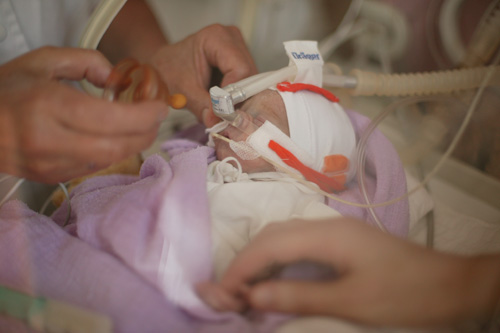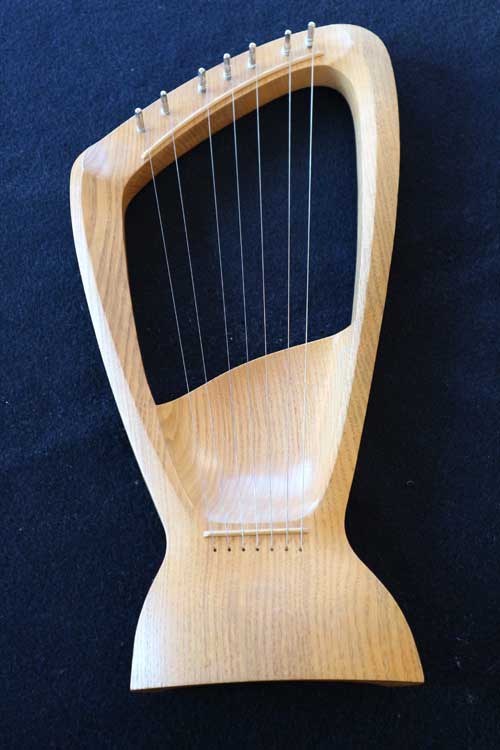Music Therapy for Premature Infants and Their Mothers
Monica Bissegger
Last update: 07.06.2019

Fig. 1: Premature infant on neonatology. © Die Filderklinik
Premature infants have been separated from their mother’s mantle of protection too early. They must now find their way in a world of strong sensory impressions. They have to cope with the turbulence and noise of a mechanized environment, with unusual pain caused by examinations and medical procedures, bright lights, a new sense of heaviness (as they are now subject to gravity), altered temperature conditions and prematurely restricted mobility. Technology has an irritating effect on the vegetative rhythms in a baby’s organism, resulting in hypersensitive reactions. These babies not only react sensitively to the external influences of their mechanized environment, they respond to what is going on in the souls of the people around them as well. The soul and spirit of the small child still live largely outside the body and only gradually move into it. The process of taking hold of the body happens over the first year of life.
The task of the team treating the newborn, together with the parents, is to create as much of a “protective mantle” as possible for the child. The premature baby needs security, protection and safety. This requires a great deal of empathy from everyone involved.
For the mother, the premature separation from her child means a sudden confrontation with life and death. The experience can be traumatic. Feelings of powerlessness and helplessness can have a destabilizing effect. The mother herself is premature in relation to her new role. The consequence of this drastic experience can be a depressive mood, hurt self-esteem, a feeling of failure, a feeling of her inability to give birth to a healthy child and thus to be a good mother. Questions about guilt and how to live with that guilt often arise. She may feel concerned about the survival of the baby, the future of her child overall, and fear that her child may end up with a disability. A mother reported: “It was as if a hurricane had struck me.”
The unity of mother and child that grew during pregnancy and should have grown further, has been interrupted. An important condition for the child to come into healthy development and for the mother to process the traumatic events is for them to establish a good mother-child relationship.
The approach and aims of music therapy

Fig. 2: Music therapy on neonatology. © Die Filderklinik
The basic idea of music therapy for premature infants is to give them back some of the “motherly mantle” that was lost too soon. With the help of music, we create an atmosphere of security, protection and safety:
a “mantel of sound” should surround the infant.
The infant is exposed to strong external sensory stimuli which can no longer be muffled by the womb. Music therapy is intended to counter these stressful stimuli with a different kind of sensory impression for a short time. This other sensory impression, the hearing of musical sounds, is an invitation to turn his attention towards this other impression. This trustful turning towards the sounds of music is also a turning towards life, a taking up of the thread of life.
We support the unity of mother and child , interrupted too early, through guiding them back together:
the “mantle” of sound should not only surround the baby, but also the baby and the mother.
When the mother and her child are able to immerse themselves in a soothing atmosphere, both can experience a post-maturation process . The lost “motherly mantle” can form again.
In this atmosphere, the mother turns inwardly to her baby with a trusting, open mood and enters into a relationship with him that is not overshadowed by feelings of guilt and fear. Rather, feelings of confidence in her child and confidence in the path that her child will take arise in her.
Music therapy also aims to show mothers how beneficial such sounds can be for their babies. Encouraging the mother to sing and supporting her in this is an important part of music therapy. The mother can experience an increase in her own competence to act.
Aims of music therapy for the baby
- To soothe
- To relax
- To deepen respiration
- To stabilize
- To balance the respiratory rate
- To balance the heart rate
- To reduce oxygen saturation drops
- To increase oxygen saturation
- To improve warmth regulation
- To relieve pain
- To foster a sense of security
- To foster a sense of safety
- To promote the bond with the mother
- To support development
Aims of music therapy for the mother
- To calm
- To relax
- To deepen respiration
- To stabilize
- To reduce fear
- To reduce feelings of being overwhelmed
- To process the birth experience
- To strengthen self-confidence and self-assurance
- To promote confidence in her role as a mother
- To promote a feeling of being competent
- To promote interaction with the infant
- To promote the bond with the infant
The effect of music therapy
Music therapy can be added to all the other measures of intensive medical and nursing care. It must adapt well and fit in flexibly. On the one hand, all acute measures have priority, on the other hand music therapy can create moments of peacefulness. Music therapy is possible whether the infant is lying in an incubator, or later in a warming bed or crib. It is preferable to let the baby lie on his mother’s breast (kangaroo method) or in her arms. It is nice when the father can also have this experience; perhaps even an older sibling can also help.
Experience has shown that small and weak babies relax when listening to music. They breathe more calmly and evenly, fall asleep more easily, and sleep more deeply.
In older babies who have slightly longer waking phases, from about the 35th week of pregnancy onwards, we can observe their active perception of the music. Their reactions to the music then become clearer and more direct, whereas they were previously more dreamlike. Their eyes move under their closed eyelids. Their mouth moves slightly. A finger may move, perhaps their whole hand or even their whole arm may move with a unique lightness. They pull their eyelids upwards in an attempt to open their eyes. Their head turns in the direction of the music. Their facial expression relaxes. Their hands open, describing slight movements in the air. A “smile” suffuses their face.
Mothers describe listening to music together as being very beneficial for them too. They can calm down, relax, leave the frightening questions behind for a while and thus find their way back to their own self-confidence and self-assurance. In this atmosphere, they wonderingly experience the gradual “awakening of their baby into the world”. Tension can gradually be released, they can “catch their breath” again. Speaking of fears and worries is made easier in this atmosphere. They can now start to process their profound experiences.
Singing is not obviously natural or even possible for all mothers at the beginning of motherhood. Letting one’s own voice be heard in singing is connected with expressing what is within. This requires an extremely trusting atmosphere. It often takes quite a while until a mother has found enough trust in the situation and in herself. It is precisely this inner soul expression inherent in the singing voice, especially in the mother’s singing voice, that makes singing so valuable in dealing with tiny infants. Mothers can be strengthened in the feeling that they can do something for their baby’s recovery process themselves, even beyond their stay in hospital. It is particularly helpful when mothers have already sung more during pregnancy and have thus strengthened their self-confidence in their own voice. A mother who found it easy to sing described her experience with her child, whom she had repeatedly sung to during the time that he had had to lie in an incubator: “I saw how I caressed my child with my singing.”
A mother’s report
“My child and I were offered music therapy. I was very curious about it – what would happen, how would we feel and how would my son react? During kangaroo resting we listened to the soft sounds of a children’s harp and singing. Surprised and joyful, I was able to feel and observe how he reacted to it: his eyes opened, his head lifted, his fist loosened and relaxed. During the music I felt his tiny body becoming more and more relaxed and heavier on my upper body, and saw how he finally fell asleep with a blissful smile.
Experiencing this tender skin contact with him and the soft tones I could also relax, calm down and let go. Thus, music time became a special space for me: far away from everyday life, fears and worries. Afterwards I felt more balanced and I had the great feeling that this closeness strengthened our confidence and will. The time of kangaroo resting and music was full of peace and harmony—a gift, because we would not have experienced this intensive togetherness if he had been born mature. We owe a lot to this ‘cuddling time’.”
Musical instruments and music
In order to find the right musical instruments and the right type of music, it is necessary to put oneself in the position of the tiny infant. The premature baby is tender, delicate, vulnerable, almost transparent. Protection, security, warmth, being carried, feeling connected are no longer provided in sufficient measure.
Musical instruments

Fig. 3: Children's harp. © Monica Bissegger
Experience has shown that the singing voice is the musical “instrument” that best suits the situation. In order to meet premature infants musically, we require a sound that has little earthly heaviness. The singing voice can most easily achieve the necessary lightness. It is guided lightly, freely and with elastic tension, entirely carried by the flow of breath. Especially hummed sounds are weightless, transparent and warm. If the sound may be allowed to become more intense, the vowels “A”, “O”, or “U” can be used. A song, thus one that has words, can make it easier for mothers to get started with singing. It can be a simple cradle song, a lullaby, a guardian angel song or a song invented by the mother herself.
In addition to the singing voice, a children’s harp (Choroi instrument) is suitable , a small stringed instrument with a peripheral, soft and delicate sound. It is an instrument with an open body. Its seven strings are tuned on a pentatonic scale from d’ to e’’ in pure fifths around the central note a’ (d’ – e’ – g’ – a’ – h’ – d’’ – e’’), without half tones. The whole encompasses a double fifth.
Music
The pentatonic scale allows us to play motifs and melodies in a “mood of the fifth” (1). The “mood of the fifth” has a floating, light and atmospheric quality. The oscillation of the tones around a middle tone conveys this floating and lightness. The intervals around the central tone a’ are the same upwards and downwards. This creates an absolute balance, an absolute equilibrium. The double fifth corresponds to the tonal space of a ninth. Here, too, you can experience lightness and the space around. It is not a polarity with a tonic note and an octave that is in the foreground, as with the diatonic scale, but a circling around a middle and thus a unity. The basic tempo is quiet. An oscillating, swinging 6/8-time beat is particularly well suited. The motifs and melodies are simple and repetitive.
A study
In a scientific study conducted by the institute Academic Research in Complementary and Integrative Medicine (ARCIM) at the hospital Filderklinik, it was shown how the music of a pentatonic harp can positively influence significant parameters of the vegetative nervous system of premature infants (2). Harp music led to relaxation in the babies, which was reflected among other things in improved heart-rate variability. In addition, there was a significant reduction in the mothers’ feelings of anxiety.
Bibliography
- Steiner R. Das Wesen des Musikalischen und das Tonerlebnis im Menschen. GA 283. 5th ed. Dornach: Rudolf Steiner Verlag; 1989.
- Ranger A, Bott TS, Ostermann T, Als H, Bassler D, Helmert E, Vagedes J. Physiological and emotional effects of pentatonic live music played for preterm neonates and their mothers in the Newborn Intensive Care Unit: A randomized controlled trial. Complementary Therapies in Medicine 2018;41:240–246.[Crossref]